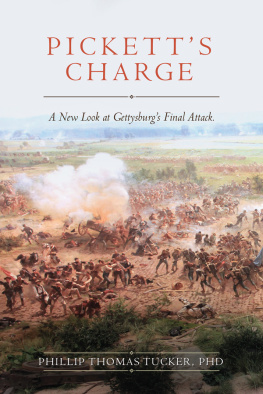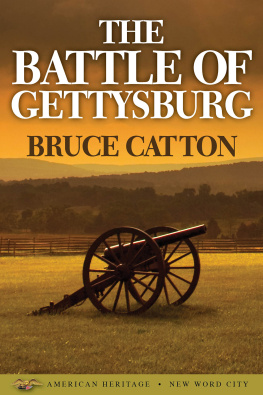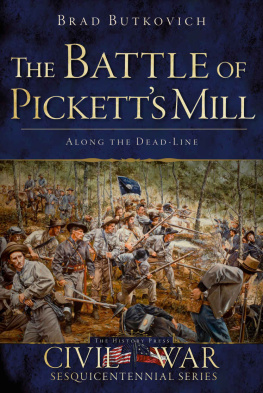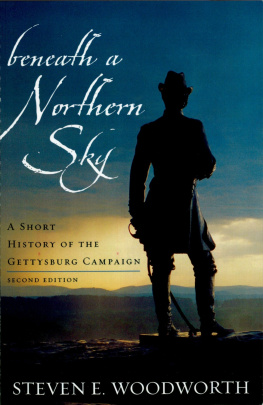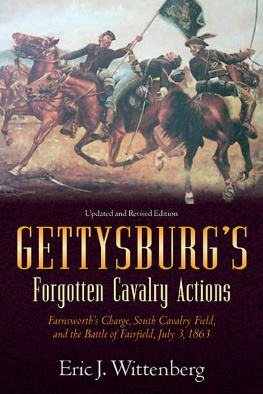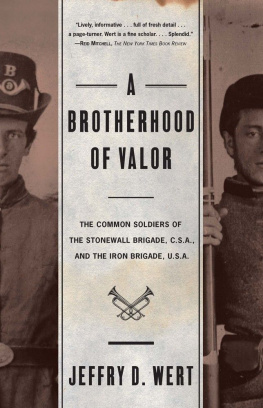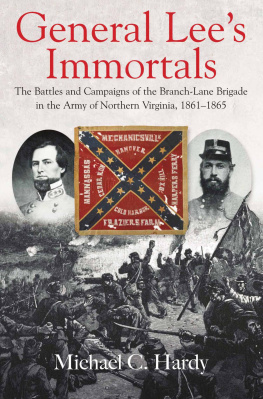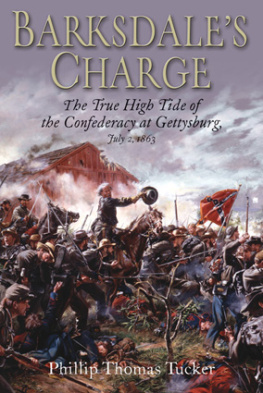Praise for
Picketts Charge
Contains much to interest and provoke Civil War enthusiasts.
Kirkus Review
In his almost minute-by-minute account of the most famous infantry charge in history, Phillip Thomas Tucker provides a thoughtful and challenging new look at the great assault at Gettysburg, from planning to aftermath. Not afraid to lay blame where he thinks it belongs, Tucker is fresh and bold in his analysis and use of sources. Even though any reader knows in advance the outcome, still Picketts Charge maintains suspense to the sound of the last gun.
William C. Davis, author of Crucible of Command: Ulysses S. Grant and Robert E. LeeThe War they Fought, the Peace they Forged
No action in the Civil War is more iconic than the misnamed Picketts Charge, and yet few episodes of this most-studied of wars is in need of more enlightened and enlightening reexamination. Phillip Thomas Tuckers magisterial Picketts Charge: A New Look at Gettysburgs Final Attack replaces 150-plus years of uninterrogated mythology with meticulously researched history to give us a new and long-overdue understanding of what tradition dismisses as Robert E. Lees most tragic error in pursuit of a Lost Cause. Tucker persuasively argues that Picketts Charge, though failed in its execution, actually reveals Lee at his most masterful. This book is one of a handful essential to gaining a full strategic and tactical appreciation of both Gettysburg and the war in which it was the turning point.
Alan Axelrod, author of The Horrid Pit: The Battle of the Crater, the Civil Wars Cruelest Mission and The 20 Most Significant Events of the Civil War
Phillip Thomas Tucker cuts through the myths and misconceptions that surround Picketts charge to offer a fresh defense of Robert E. Lee and a probing examination of what happened that fateful afternoon. The result is a thought-provoking and eye-opening study of this pivotal moment in American history.
Louis P. Masur, Rutgers University History professor, and author of The Civil War: A Concise History
In nearly all recent surveys, Americans list the Battle of Gettysburg as the most recognizable and most important of all battles in our history. And, when asked what they know about Gettysburg, to top of that list is Picketts Charge. When pressed a little harder, if they know anything about the charge, most will say it was a disaster, that General Lee didnt know what he was doing, that there was no way it could have succeeded, and so forth. Relying heavily on the combatantss first-hand accounts, Phillip Thomas Tucker cuts away the myths and offers a fresh new interpretation that challenges long held views of the story. Rather than seeing Picketts Charge as foolhardy, Tucker considers Lees plan as a stroke of genius, and that, had a few things gone differently, could well have ended the war in favor of the Confederacy.
Robert K. Sutton, former Chief Historian, National Park Service
Copyright 2016 by Phillip Thomas Tucker
All rights reserved. No part of this book may be reproduced in any manner without the express written consent of the publisher, except in the case of brief excerpts in critical reviews or articles. All inquiries should be addressed to Skyhorse Publishing, 307 West 36th Street, 11th Floor, New York, NY 10018.
Skyhorse Publishing books may be purchased in bulk at special discounts for sales promotion, corporate gifts, fund-raising, or educational purposes. Special editions can also be created to specifications. For details, contact the Special Sales Department, Skyhorse Publishing, 307 West 36th Street, 11th Floor, New York, NY 10018 or .
Skyhorse and Skyhorse Publishing are registered trademarks of Skyhorse Publishing, Inc., a Delaware corporation.
Visit our website at www.skyhorsepublishing.com.
10 9 8 7 6 5 4 3 2 1
Library of Congress Cataloging-in-Publication Data is available on file.
Cover design by Rain Saukas
Cover art courtesy of the Gettysburg Foundation. Detail of The Battle of Gettysburg, Paul Dominique Philippoteaux, located at the Gettysburg Visitor Center and Museum, Gettysburg National Military Park, Gettysburg, Pennsylvania.
Print ISBN: 978-1-63450-796-7
Ebook ISBN: 978-1-63450-802-5
Printed in the United States of America
Dedication
To the good people at Skyhorse Publishing, especially
Bill Wolfsthal and Mike Lewis.
Contents
Gettysburg Time Line: Leading up to Picketts Charge
June 28, 1863
General Robert E. Lee and Lieutenant General James Longstreet, in Chambersburg, Pennsylvania, receive word that the Federal Army of the Potomac is heading into Pennsylvania.
June 30
Two brigades from John Bufords Union cavalry division scout ahead and enter Gettysburg. Finding signs of Confederates nearby to the northwest, Buford sends word to Major General John Reynolds in Emmitsburg, Maryland, to bring his infantry as soon as possible.
July 1
5:00 a.m. Major General Henry Heths division, and Lieutenant General Ambrose Powell Hills 3rd Corps, Army of Northern Virginia, depart Cashtown, Pennsylvania, and march for Gettysburg.
7:00 a.m. Advance elements of Heths division are spied by a Federal signal corps officer from the cupola of the Lutheran Seminary on Seminary Ridge.
7:30 a.m. First shot fired three miles NW of Gettysburg at intersection of Knoxlyn Road and Chambersburg Pike by Lieutenant Marcellus Jones of the 8th Illinois Calvary, Bufords cavalry division, against Major General Henry Heths division of A.P. Hills corps.
8:00 a.m. Buford begins to deploy his cavalry units in a main line on McPhersons Ridge, west of Gettysburg, and on Herrs Ridge just west of McPhersons Ridge. With his troopers dismounted and in good defensive positions, Bufords vital mission is to hold firm as long as possible to buy time for the arrival of the 1st Corps, and keep the Confederates from gaining the defensive high-ground.
9:30 a.m. Heths troops are unleashed, attacking the lengthy lines of Bufords cavalry division.
10:15 a.m. Advance elements of the 1st Corps, under Major General Reynolds, arrive on the field and reinforce Bufords division.
10:30 a.m. Reynolds and two brigades of the Union 1st Corps infantry arrive and join the line along McPherson Ridge. One is the Iron Brigade, the other is the PA Bucktail Brigade. A bullet through the base of his skull kills Reynolds. Major General Abner Doubleday takes command of the Union 1st Corps.
11:00 a.m. Two divisions of the Union 11th Corps arrive and take positions north of town. Lee and staff reach Cashtown and hear the heavy firing. Having been convinced that the Army of the Potomac was still in Maryland below the Pennsylvania line, Lee is shocked by the sounds of heavy fighting because he had ordered his commanders to avoid a major confrontation. Despite his best efforts, Lee cannot gain intelligence about what is happening.
11:15 a.m. Major General George G. Meade, the Army of the Potomacs new commander, dispatches additional units north to Gettysburg from his Taneytown, Maryland, headquarters.
12:15 p.m. Units of the 11th Corps take possession of the strategic high-ground of Cemetery Hill (at the northern end of Cemetery Ridge). Reynolds is now determined to keep this strategic position out of Rebel hands at all costs.
1:00 p.m. Major General Winfield Scott Hancock is dispatched by Meade to ascertain if good ground exists to fight a major battle. Hancocknow in command of all Union forces at Gettysburg because Meade was not yet on the fieldorders hard-hit Federal units to retire to Cemetery Hill. Hancock decides to defend Cemetery Hill and Culps Hill, establishing a solid anchor for a defensive stand.
Next page
